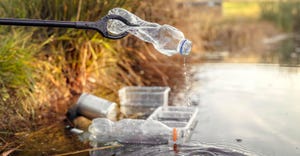How Controlling Leachate on the Front End at Landfills Can Minimize Headaches Later
Leachate management is among landfill owners’ highest operating costs, up to 30 percent, according to a Brown and Caldwell report.
Leachate management is among landfill owners’ highest operating costs, up to 30 percent, according to a Brown and Caldwell report. And those costs are climbing as regulations tighten due to burdened wastewater treatment plants, with more and different compounds making their way into streams.
As treatment plants’ loads increase, landfills are sometimes cut off from them, says Darrin Dillah, vice president of SCS Engineers. This means they need need to move leachate further, which drives up costs and creates a problem further compounded by recent, historically high rain falls.
Meanwhile, “Liquid infiltration can impact waste settlement or compaction, which translates to air space, gas production and change in leachate volume and quality,” says Stephanie Bolyard, research and scholarship program manager at the Environmental Research & Education Foundation (EREF).
So landfill operators are finding ways to minimize leachate on the front end rather than treat it later, sometimes saving millions of dollars over time.
A key strategy in achieving this is managing liquid as storm water.
“For every inch of rainwater over an acre, you are talking about 27,000 gallons of liquid," says Dillah. "The volume can add up fast. It’s more cost effective to manage as storm water, making your best effort upfront to keep it from becoming leachate.”
This requires having a barrier on the landfill surface—ensuring the cap is well maintained—and having effective storm drain systems such as down chutes or storm water channels.
Prince George’s County, Md.’s Brown Station Road Sanitary Landfill has a permitted design that outlines different elevations for directing storm water to structures such as storm water down chutes. And it has benching and channels that water is directed to in order to reduce leachate that infiltrates the collection system.
The leachate conveyance system’s protective cover is also used to redirect storm water before it becomes leachate. Water is collected from individual cells, enabling separation of storm water from leachate, says Bruce O’Dell, disposal section manager of the resource recovery division of Prince George’s County department of the environment.
Captured liquid is treated as storm water and pumped into storm water channels. Cells are 10 or 15 acres each with capacity for 27,000 gallons of leachate per acre, much of which is minimized.
A computerized GPS at the Prince George’s site provides information about elevation and compaction, which is relayed to workers in the field. The GPS allows operations staff to stay in their office while keeping them up on how the landfill is graded and providing information about compaction to be sure the site is properly draining.
Strategically designed covers on outside slopes minimize erosion.
“As we move higher in elevation, we use soils as cover on the outside slopes," says Darryl Flick of the Prince George’s County department of environment director’s office. "We require vegetation to grow quickly to stabilize the slopes, which minimizes erosion.”
There is technology to help narrow down leachate source and cause.
The active Area B site at the Prince George’s facility has 11 cells in a 10- to 15-acre range, and each has its own collection area. So staff can collect and test leachate by cell. They can also test by north side or south or by conglomerate of all of these.
“The cover and cap work better in some areas than others … This offers some ability to manage data and to determine which cell has more or less leachate. This helps when we are troubleshooting,” says Flick.
EREF is currently conducting a survey on leachate minimization techniques utilized at landfills across the U.S. Preliminary results show that 47 percent of respondents had some form of minimization technique. These techniques included daily covers, tarps, capped landfill, temporary cover, alternative covers, storm water diversion and vegetation.
Operators find the investment worthwhile.
“Unlike landfill gas, leachate has no value; it’s nothing more than a financial burden," says Flick. "Any way that we can expand our knowledge to minimize leachate and shed liquids as storm water is exciting to us. It equates to tax dollars saved."
Flick goes on to explain that there are influences that we have no control over, such as Mother Nature.
"Who would have thought we’d have more than 50 inches of rain in Houston? … We are also limited to what volumes we can discharge to the wastewater treatment facility," says Flick. "Our best measure of control is to minimize leachate. It’s a critical balancing act. We are continuing to improve our designs and operations [to minimize] leachate production.”
About the Author
You May Also Like




